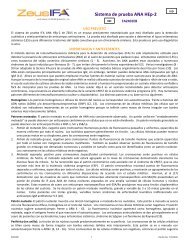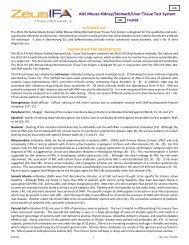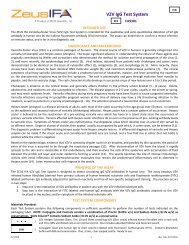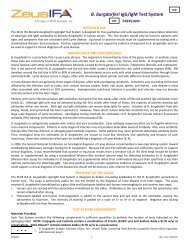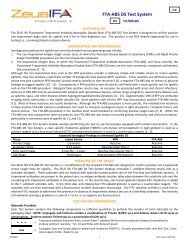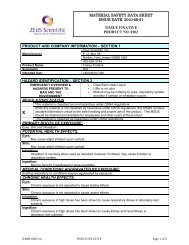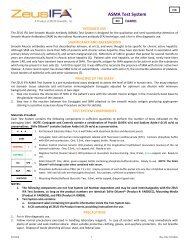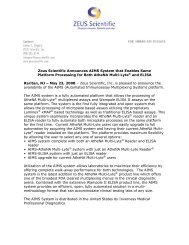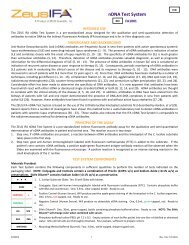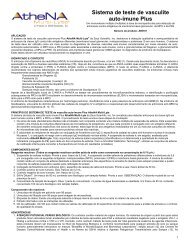MSDS - ZEUS Scientific
MSDS - ZEUS Scientific
MSDS - ZEUS Scientific
You also want an ePaper? Increase the reach of your titles
YUMPU automatically turns print PDFs into web optimized ePapers that Google loves.
MATERIAL SAFETY DATA SHEETIssue Date: 2012-06-13ELISA Mycoplasma IgG Test SystemProduct No. 3Z17601GPRODUCT AND COMPANY INFORMATION – SECTION 1<strong>ZEUS</strong> <strong>Scientific</strong>, Inc.Manufacturer P. O. Box 38Raritan, New Jersey 08869 USAProduct Name:SynonymsIntended Use:HAZARD IDENTIFICATION – SECTION 2EMERGENCY OVERVIEW &HAZARDS PRESENT TOMAN AND THEENVIRONMENT908-526-3744ELISA Mycoplasma IgG Test SystemN/ALaboratory UsePoison. Danger. Corrosive. Liquid and mist cause severeburns to all body tissue. May be fatal if swallowed or inhaled.Inhalation may cause lung damageREGULATORY STATUSThis material is classified as non-hazardous under OSHA regulations.While this material is not classified as hazardous under OSHA regulations, this <strong>MSDS</strong> containsvaluable information critical to the safe handling and proper use of the product. This <strong>MSDS</strong>should be retained and available for employees and other users of the product.This material is classified as hazardous under OSHA regulations.XPRIMARY ROOTS OF EXPOSURE:Inhalation, Skin, IngestionPOTENTIAL HEALTH EFFECTS:Eyes:Vapors are irritating and may cause damage to the eyes. Contact may cause severe burns andpermanent eye damageSkinCan cause redness, pain, and severe skin burns. Concentrated solutions cause deep ulcers and discolorskin.Inhalation:Inhalation of vapors can cause coughing, choking, inflammation of the nose, throat, and upper respiratorytract, and in severe cases, pulmonary edema, circulatory failure, and death.Ingestion:Swallowing hydrochloric acid can cause immediate pain and burns of the mouth, throat, esophagus andgastrointestinal tract. May cause nausea, vomiting, and diarrhea. Swallowing may be fatal.MEDICAL CONDITIONS AGGRAVATED BY EXPOSURE:Persons with pre-existing skin disorders or eye disease may be more susceptible to the effects of thissubstance.CHRONIC HEALTH EFFECTS:Eyes:Long-term exposures seldom occur due to the corrosive properties of the acid.Skin:Repeated exposure to low concentrations of acid solutions, mist or vapor can cause redness, swellingand pain (dermatitis).Inhalation:(EIA PSD-00038) ELISA Mycoplasma IgG Test System Page 1 of 7
In fires fueled by other materials, hydrogen chloride may be released.Extinguishing Media:If involved in a fire, use water spray. Neutralize with soda ash or slaked lime.Prohibited Extinguishing Media:None identified.Firefighting Instructions:In the event of a fire, wear full protective clothing and NIOSH-approved self-contained breathingapparatus with full face piece operated in the pressure demand or other positive pressure mode.Structural firefighter’s protective clothing is ineffective for fires involving hydrochloric acid.Unusual Fire and Explosion Hazards:Extreme heat or contact with metals can release flammable hydrogen gas.ACCIDENTAL RELEASE MEASURES – SECTION 6Personnel Precautions:Wear appropriate personal protective equipment as specified in Section 8.Environmental Precautions:Do not flush to sewer. US Regulations (CERCLA) requires reporting spills and releases to soil, water andair in excess of reportable quantities. The toll free number for the US Coast Guard National ResponseCenter is (800)424-8802.Cleanup Methods:Ventilate area of leak or spill. Isolate hazard area. Keep unnecessary and unprotected personnel fromentering. Contain and recover liquid when possible. Neutralize with alkaline material (soda ash, lime),then absorb with an inert material (e.g., vermiculite, dry sand, and earth), and place in a chemical wastecontainer. Do not use combustible material such as sawdust.HANDLING AND STORAGE – SECTION 7Handling:Do not wash out container and use it for other purposes. When diluting, the acid should always be addedslowly to water and in small amounts. Never use hot water and never add water to the acid. Water addedto acid can cause uncontrolled boiling and splashing. When opening metal containers, use non-sparkingtools due to the possible presence of hydrogen. Containers containing this material may be hazardouswhen empty since they retain product residues.Storage:Store in a cool, dry, ventilated storage area with acid resistant floors and good drainage. Protect fromphysical damage. Keep out of direct sunlight and away from heat, water, and incompatible materialsSpecific Uses:Product is intended for laboratory use.EXPOSURE CONTROLS/PERSONAL PROTECTION – SECTION 8EXPOSURE CONTROLS:Exposure Limit Values:OSHA PEL:ACGIH TLV:Glycerol 15mg/m 3 (Total Dust: Glycerin Mist)310 mg/m (Vapor)35mg/m (Respirable Fraction:Glycerin Mist)Hydrochloric Acid (HCl) 7mg/m 3 (Ceiling)7.5mg/m(Ceiling)Sodium Azide 0.3 mg/ m 3 0.29 mg/ m 3Engineering Controls:A system of local and/or general exhaust is recommended to keep employee exposures below theAirborne Exposure Limits. Local exhaust ventilation is generally preferred due to its ability to control theemissions of the contaminant at its source, preventing dispersion of vapors into the general work area.PERSONAL PROTECTIVE EQUIPMENT:Respiratory Protection:NIOSH Approved Personal Respirators should be utilized. If the exposure limit is exceeded, a full face(EIA PSD-00038) ELISA Mycoplasma IgG Test System Page 3 of 7
piece respirator with an acid gas cartridge may be worn up to 50 times the exposure limit or the maximumuse concentration specified by the appropriate regulatory agency or respirator supplier, whichever islowest. For emergencies or instances where the exposure levels are not known, use a full-face piecepositive-pressure, air-supplied respirator.Hand Protection:Rubber or neoprene gloves should be worn when handling this materialEye/Face Protection:Use chemical safety goggles and/or a full face shield where splashing is possible. Maintain eye washfountain and quick-drench facilities in work area.Skin Protection:Impervious boots, apron, or coveralls should be worn as needed in areas of unusual exposure to preventskin contact.General Hygiene Considerations:No information available.Other Protective Equipment:No additional PPE required.PHYSICAL & CHEMICAL PROPERTIES – SECTION 9PRODUCT:ELISA Mycoplasma IgG Test SystemGeneral Information:AppearanceClear/Semi-Clear LiquidOdorPungent odor of hydrogen chlorideImportant Health, Safety, and Environmental Information:Boiling Point53°C (127°F) (HCl)Melting Point-74°C (-101°F) (HCl)Flash PointN/AExplosive PropertiesN/AOxidizing PropertiesNo information availableSpecific Gravity (H 2 O = 1)1.16 (HCl)pH1 (HCl)Water SolubilitySolublePartition Coefficient (n-octanoll water)No information available.ViscosityNo information available.Vapor Pressure (mm Hg)25 mm of Hg @ 25°C (77°F) (HCl)Vapor Density (Air = 1)No information availableEvaporation RateNo information available.% Volatile (By Volume @ 68ºF) 100 (HCl)STABILITY & REACTIVITY – SECTION 10Stability:Stable under normal conditions of use and storage. Containers may burst when heated.Conditions to Avoid:Avoid heat and direct sunlight.Materials to Avoid:A strong mineral acid, concentrated hydrochloric acid is incompatible with many substances and highlyreactive with strong bases, metals, metal oxides, hydroxides, amines, carbonates and other alkalinematerials. Incompatible with materials such as cyanides, sulfides, sulfites, and formaldehyde.Hazardous Decomposition Products:When heated to decomposition emits toxic hydrogen chloride fumes and will react with water or steam toproduce heat and toxic and corrosive fumes. Thermal oxidative decomposition produces toxic chlorinefumes and explosive hydrogen gas.Hazardous Polymerization:Will not occur.(EIA PSD-00038) ELISA Mycoplasma IgG Test System Page 4 of 7
TOXICOLOGICAL INFORMATION – SECTION 11Type of Test Route ofExposureAlbumin, Bovine Serum:TDIntraperitonealLoEffectsImmunologicalincluding allergic –increase inhumoral immuneresponseGlycerol:LD50 OralDetails of toxiceffects notreported otherthan lethal dosevalue.HCl:LC50 Inhalation Lungs, Thorax, orRespiration –acute pulmonaryedema.Sodium Azide:LD50 OralDetails of toxiceffects notreported otherthan lethal dosevalue.Sodium Chloride:LD50 OralDetails of toxiceffects notreported otherthan lethal dosevalue.Sodium Sulfate:LD50 OralDetails of toxiceffects notreported otherthan lethal dosevalue.Tween 20 (Polyoxyethylene (20) sorbitan monolaurate):LD50 OralDetails of toxiceffects notreported otherthan lethal dosevalue.SpeciesObservedRodent – MouseRodent – RatDose Data0.2 pph12600 mg/kgRodent – Rat 7004 mg/m 3 /30MRodent – RatRodent – ratRodent – MouseRodent – rat27 mg/kg3000 mg/kg5989 mg/kg36700 UL/KGECOLOGICAL INFORMATION – SECTION 12Ecotoxicity:This material is expected to be toxic to aquatic life.Mobility:When released into the soil, this material may leach into groundwater.Persistence and Degradability:When released into the soil, this material is not expected to biodegrade.Bioaccumulative Potential:No information available.(EIA PSD-00038) ELISA Mycoplasma IgG Test System Page 5 of 7
DISPOSAL CONSIDERATION – SECTION 13Disposal should be in accordance with Local, State, and Federal regulations.TRANSPORT INFORMATION – SECTION 14DOT CLASSIFICATION:UN Number:Class:Proper Shipping Name:Packing Group:Marine Pollutant:Other Information:IATA CLASSIFICATION:UN Number:Class:Proper Shipping Name:Packing Group:Marine Pollutant:Other Information:IMDG CLASSIFICATION:UN Number:Class:Proper Shipping Name:Packing Group:Marine Pollutant:Other Information:REGULATORY INFORMATION – SECTION 15U.S. REGULATIONSACGIHCAA Section 112CERCLAIARCNTPOSHASARA Title IIITSCASTATE REGULATIONSMA Substance ListNJ RTK Hazardous Substance ListPA Hazardous Substance ListCanadian WHMISEUROPEAN UNIONRisk Phrases:R22: Harmful if swallowedN/AORM-DConsumer CommodityN/AN/AN/AID80009Consumer CommodityN/AN/AN/AUN 17898Hydrochloric Acid, solutionIIN/ALimited QuantityListed: (HCl) (TLV: 7.5 mg/m 3 ) (Ceiling) (SodiumAzide) (TLV: 0.29 mg/m 3 ) (Ceiling) (Glycerol)(TLV:10 mg/m 3 ) (Vapor)Listed: (HCl)Listed: (HCl: (RQ=5000 lbs.)(Sodium Azide: RQ – 1000 lbs.)Not ListedNot ListedListed: (HCl) (PEL: 7 mg/m 3 ) (Ceiling) (SodiumAzide) (PEL: 0.3 mg/m 3 ) (Ceiling) (Total Dust:Glycerin Mist) (PEL:15 mg/m 3 ) (RespirableFraction: Glycerin Mist) (5mg/ m 3 )Listed (Hydrogen Chloride: gas only)(Sodium Azide)Listed (HCl) (Sodium Azide) (Sodium Chloride)Listed (HCl) (Glycerin Mist) (Sodium Azide)Listed (HCl) (Sodium Azide)Listed (1,2,3 Propanetriol) (Sodium Azide)Listed (HCl) (Sodium Azide)(EIA PSD-00038) ELISA Mycoplasma IgG Test System Page 6 of 7



